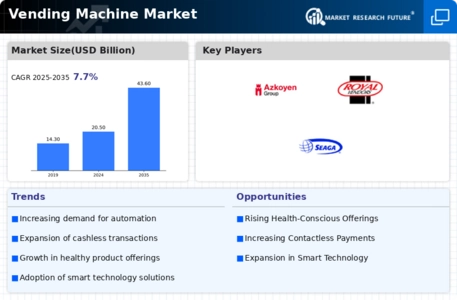Increasing demand for on-the-go snacks and beverages is driving the market growth
Due to customers' busy lifestyles, there is an increasing need for on-the-go snacks and beverages, which is driving product sales through vending machines. The industry's expansion can also be attributable to these machines' speedy delivery of goods, which gives customers a very practical choice. A vending machine makes it easier to access food and beverages in a variety of locations, including businesses, upscale restaurants, crowded pubs, and public spaces. This will probably increase demand for them in turn.
Lockdowns have had a negative impact on the supply chain, which has negatively impacted the consumer goods industry as a result of the coronavirus epidemic. It will probably have a complicated effect on food and beverage firms, affecting both supply and demand.
As opposed to this, a shift in consumer behaviour has been seen, creating demand for a variety of consumer items, with some customers switching between brands. Manufacturers are simultaneously evaluating how to handle potential disruptions throughout the supply chain and locating opportunities to enhance and satisfy customer demand. Operators of vending machines have noticed the effects and a decline in revenue, particularly in April 2020 compared to 2019.
Given that they can sell more than simply snacks and drinks, such as cigarettes and lottery tickets, vending machine sales appear to be promising. As a result, by strategically deploying these devices in places like corporate buildings, schools, malls, railway stations, and airports, among others, operators can collect enormous money. For instance, it was reported in August 2019 that over 1 million plastic bottles have been recycled by Iceland retailers' reverse vending machines. Due to rising consumer awareness of nutritious food and beverage options, the healthy living trend is gaining ground all over the world.
The Vending People's 2019 research shows that sales of zero-sugar beverages increased by 38.2% in the U.K. from the first half of 2018 to the first half of 2019, whereas sales of beverages with a high sugar content saw the sharpest decline. When compared to the same period last year, sales of these drinks decreased by 19.8%. Customers are looking for healthier substitutes, as seen by the 196% sales increase of low-calorie beverages over other beverages.
During the projection period, it is anticipated that there will be a rise in the demand for food vending machines in workplaces and institutions. Additionally, the expansion of the vending equipment market size is anticipated to be fueled by the rise in food item consumption and the consequent implementation of smart customer service technologies in a number of food categories. Due to customers' busy lifestyles nowadays, the growing need for on-the-go snacks, drinks, etc. is a major driver of the Vending Machine Market's expansion.
Furthermore, advancements in manufacturing processes, including material testing for vending components, are contributing to the development of more durable and efficient machines.
The ability of vending machines to quickly deliver the products, making it convenient for the consumers including flexibility in terms of location and time because the machines are operated 24/7 without manual intervention, is another factor anticipated to drive the market growth over the upcoming years. The increased need for on-the-go snacks and beverages, people's busy lifestyles, and the vending machine's capacity to offer goods rapidly, which makes it an exceptionally handy option for customers, are the main reasons propelling the expansion of the vending machine market size. Thus, driving the vending equipment market revenue.
The Global Vending Machine Market is poised for transformation as consumer preferences shift towards healthier options and technological advancements enhance user experience.
U.S. Department of Commerce















Leave a Comment